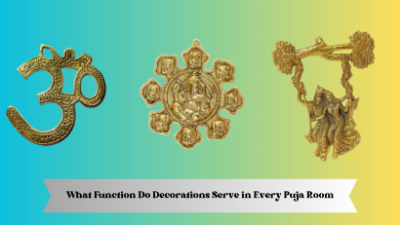
Decorations in a puja room serve several important functions that contribute to the overall atmosphere of devotion, spirituality, and reverence. Here are some of the key functions that decorations fulfill in a puja room
1. Creating a Sacred Atmosphere: Decorations play a crucial role in transforming a regular space into a sacred and consecrated area. The arrangement of religious symbols, images of deities, and sacred texts contributes to the spiritual ambiance of the room.
2. Fostering Devotion and Concentration: Thoughtfully placed decorations can help individuals focus their attention and cultivate a sense of devotion during their worship and prayers. Colors, symbols, and images that are associated with specific deities or spiritual concepts aid in creating a conducive environment for meditation and contemplation.
3. Establishing a Visual Focal Point: Decorations often include images or idols of deities, which become the central focal point of the puja room. This focal point serves as the visual representation of the divine, providing a point of focus for prayers and rituals.
4. Symbolic Representation: Many decorations in a puja room have symbolic significance. Symbols, such as lotus flowers, conch shells, and holy scriptures, convey spiritual meanings and teachings. These symbols remind worshippers of the deeper aspects of their faith and its teachings.
5. Invoking Divine Presence: The decorations are not merely ornamental; they are believed to invoke the presence of the deities and spiritual energies. As worshippers engage with the decorations and offer their devotion, they believe that the divine entities are drawn into the space.
6. Reflecting Personal Beliefs: Decorations in a puja room often reflect the personal beliefs and spiritual path of the individuals who use the space. People may choose specific deities, symbols, and items that hold personal significance to them or their family's tradition.
7. Enhancing Aesthetic Appeal: While the primary purpose of a puja room is to facilitate spiritual practices, aesthetics also play a role. Well-chosen decorations contribute to the beauty and visual appeal of the space, making it a welcoming and serene environment for prayer and meditation.
8. Transmitting Cultural Heritage: Decorations in a puja room can also reflect the cultural heritage and traditions of the worshippers. Different regions and communities have unique ways of decorating their puja spaces, showcasing their cultural identity and customs.
9. Encouraging Regular Practice: An inviting and beautifully adorned puja room can motivate individuals to engage in regular spiritual practices. The atmosphere created by the decorations encourages a sense of commitment to maintaining a consistent practice of prayer and meditation.
In summary, decorations in a puja room go beyond mere aesthetics; they are an integral part of creating a spiritual environment that supports devotion, meditation, and connection with the divine. Each decoration contributes to the overall purpose of the puja room and the spiritual journey of the practitioner.




